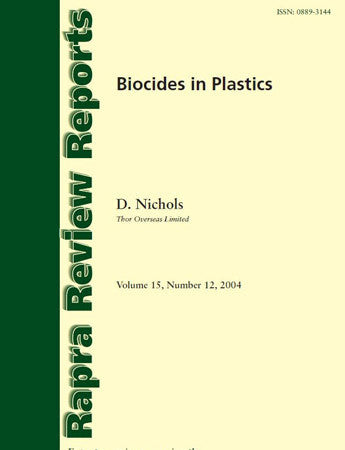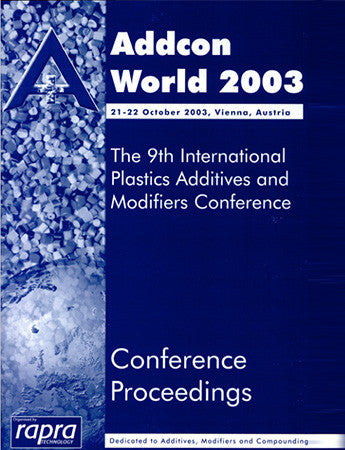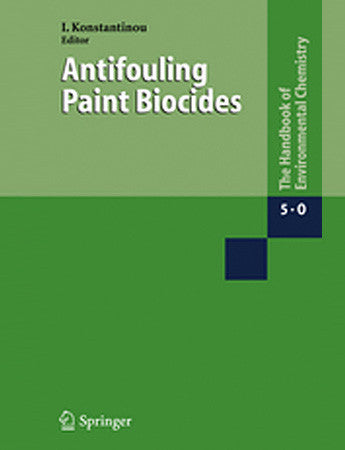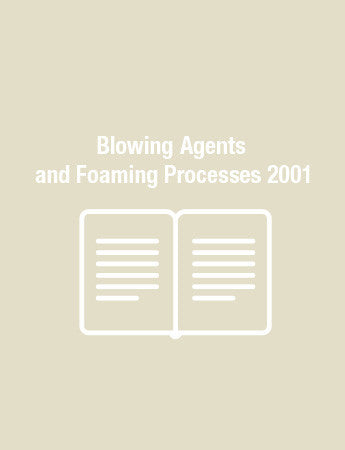Biocides in Plastics
The use of biocides in plastics is commonplace. They are added to protect the plastic from degradation by microbes or to provide an external antimicrobial hygienic surface.
Biocides are selected on the basis of their function and the application for which they are intended, but choosing the right biocide is often not so simple. As well as biocidal performance, the in-process stability, migration, leachability, light and heat stability may all be important factors.
This Rapra Review Report examines the use of biocides in plastics with reference to material types and application requirements. The commonly available biocides are reviewed and details of their strengths and weaknesses are provided. The author reviews the frequently used test methods for fungi and bacteria, and, in an ever-changing regulatory environment, explores the influence of legislation on the current and future use of such biocides.
This report will be of interest to biocide suppliers and plastic product manufacturers, and to all professionals requiring information on biocide chemistry and application.
This detailed and state-of-the-art review is supported by an indexed section containing several hundred key references and abstracts selected from the Polymer Library.
Biocides are selected on the basis of their function and the application for which they are intended, but choosing the right biocide is often not so simple. As well as biocidal performance, the in-process stability, migration, leachability, light and heat stability may all be important factors.
This Rapra Review Report examines the use of biocides in plastics with reference to material types and application requirements. The commonly available biocides are reviewed and details of their strengths and weaknesses are provided. The author reviews the frequently used test methods for fungi and bacteria, and, in an ever-changing regulatory environment, explores the influence of legislation on the current and future use of such biocides.
This report will be of interest to biocide suppliers and plastic product manufacturers, and to all professionals requiring information on biocide chemistry and application.
This detailed and state-of-the-art review is supported by an indexed section containing several hundred key references and abstracts selected from the Polymer Library.
1 INTRODUCTION
2.1 Bacteria
2.2 Fungi
2.3 Algae
2 THE NEED FOR BIOCIDES IN PLASTICS AND BASIC MICROBIOLOGY
3 PLASTIC MATERIALS REQUIRING BIOCIDES
3.1 Biostabiliser Effects
3.1.1 Nutrient Sources for Fungi and Bacteria
3.1.2 Microbiological Effects
3.1.3 Organisms of Importance
3.2 Hygienic Applications
3.2.1 Organisms of Interest
3.2.2 Merits of Such Biocides
3.2.3 The Bacterial Problem
3.2.4 False Claims
3.2.5 Conclusions Regarding Hygienic Applications
3.3 Active Packaging
4 TEST METHODS
4.1 Fungal Test Methods
4.1.1 Fungicidal Procedures
4.1.2 Fungistatic Procedures
4.1.3 Soil Burial
4.1.4 Humidity Chamber or Vermiculite Bed
4.2 Bacterial Test Methods
4.2.1 Resistance of Plastic to Bacteria
4.2.2 Antimicrobial Plastic
4.2.3 Pink Stain Test
4.3 Laboratory Tests versus use Conditions
5 AVAILABLE ACTIVE INGREDIENTS
5.1 Migratory Biocides
5.1.1 OBPA
5.1.2 OIT
5.1.3 Butyl BIT
5.1.4 Zinc Pyrithione
5.1.5 Iodo-Propylbutyl Carbamate (IPBC)
5.1.6 N-Haloalkylthio Compounds
5.1.7 Carbendazim (N-benzimidazol-2-ylcarbamic acid methylester)
5.1.8 Bethoxazin (3-Benzo(b)thien-2-yl-5,6-dihydro-1,4,2-oxathiazine 4-oxide)
5.2 Non or Low Migratory Biocides
5.2.1 Triclosan (2,2,4-dicholoro-2-hydroxydiphenyl ether)
5.2.2 DCOIT
5.2.3 Silver
5.2.4 Sustainable Antimicrobial Polymers (Degussa)
5.2.5 Titanium Dioxide Nanoparticles
5.3 Other Ingredients
6 LEGISLATION REGARDING BIOCIDES
6.1 Limitations of Use
6.2 Future Requirements
6.3 BPD Exemptions
7 SUMMARY
Additional References
Unpublished References
Bibliography
Acknowledgements
Abbreviations
Subject Index
Company Index
2.1 Bacteria
2.2 Fungi
2.3 Algae
2 THE NEED FOR BIOCIDES IN PLASTICS AND BASIC MICROBIOLOGY
3 PLASTIC MATERIALS REQUIRING BIOCIDES
3.1 Biostabiliser Effects
3.1.1 Nutrient Sources for Fungi and Bacteria
3.1.2 Microbiological Effects
3.1.3 Organisms of Importance
3.2 Hygienic Applications
3.2.1 Organisms of Interest
3.2.2 Merits of Such Biocides
3.2.3 The Bacterial Problem
3.2.4 False Claims
3.2.5 Conclusions Regarding Hygienic Applications
3.3 Active Packaging
4 TEST METHODS
4.1 Fungal Test Methods
4.1.1 Fungicidal Procedures
4.1.2 Fungistatic Procedures
4.1.3 Soil Burial
4.1.4 Humidity Chamber or Vermiculite Bed
4.2 Bacterial Test Methods
4.2.1 Resistance of Plastic to Bacteria
4.2.2 Antimicrobial Plastic
4.2.3 Pink Stain Test
4.3 Laboratory Tests versus use Conditions
5 AVAILABLE ACTIVE INGREDIENTS
5.1 Migratory Biocides
5.1.1 OBPA
5.1.2 OIT
5.1.3 Butyl BIT
5.1.4 Zinc Pyrithione
5.1.5 Iodo-Propylbutyl Carbamate (IPBC)
5.1.6 N-Haloalkylthio Compounds
5.1.7 Carbendazim (N-benzimidazol-2-ylcarbamic acid methylester)
5.1.8 Bethoxazin (3-Benzo(b)thien-2-yl-5,6-dihydro-1,4,2-oxathiazine 4-oxide)
5.2 Non or Low Migratory Biocides
5.2.1 Triclosan (2,2,4-dicholoro-2-hydroxydiphenyl ether)
5.2.2 DCOIT
5.2.3 Silver
5.2.4 Sustainable Antimicrobial Polymers (Degussa)
5.2.5 Titanium Dioxide Nanoparticles
5.3 Other Ingredients
6 LEGISLATION REGARDING BIOCIDES
6.1 Limitations of Use
6.2 Future Requirements
6.3 BPD Exemptions
7 SUMMARY
Additional References
Unpublished References
Bibliography
Acknowledgements
Abbreviations
Subject Index
Company Index
Dean Nichols has a BSc. (Hons.) degree in biology and has worked for THOR, a speciality chemicals company and leading biocide company, for the past 15 years. His experience has involved research and development and marketing of biocides and other speciality chemicals to the Middle East, Europe and some countries in the Far East. Currently, he is a member of Thors biocide product management team and has a global role for promotion of products, services and expertise into various market sectors.
Related Products
Addcon World 2003
$195.00
{"id":11242247108,"title":"Addcon World 2003","handle":"978-1-85957-370-9","description":"\u003ch5\u003eDescription\u003c\/h5\u003e\nAuthor: Conference Proceedings \u003cbr\u003eISBN 978-1-85957-370-9 \u003cbr\u003e\u003cbr\u003eVienna, Austria, 21-22 October 2003\u003cbr\u003e\u003cbr\u003epages 243\u003cbr\u003e\n\u003ch5\u003eSummary\u003c\/h5\u003e\nAddcon World 2003 was the 9th international conference on additives for plastics. The two-day conference focused on the technical advances and issues facing the plastics additives and modifiers industry. Papers consider value creation in the additives business and various aspects of additive technology, including flame retardants, stabilisers, process aids, compatibilisers, impact modifiers, and new pigments\n\u003ch5\u003eTable of Contents\u003c\/h5\u003e\nList of Papers \u003cbr\u003e\u003cbr\u003e\u003cstrong\u003eSESSION ONE - ADDITIVE MARKET TRENDS\u003c\/strong\u003e \u003cbr\u003eMarkets for Plastics Additives\u003cbr\u003eGeoff Pritchard, Hallow Plastics\/Rapra, UK Plastics Additives Market in China\u003cbr\u003eRobert Constable, Fred Gastrock \u0026amp; Louis Kattas, BRG Townsend Inc, USA End Users and Additives Suppliers: Where are the Fields of Understanding and Mutual Value Creation?\u003cbr\u003eRaphael Mestanza, SpecialChem, France \u003cbr\u003e\u003cstrong\u003eSESSION TWO - COMPATIBILISERS\/ FORMULATION SOFTWARE\u003c\/strong\u003e \u003cbr\u003eCompatibilisation of Polypropylene\/Polystyrene Blends by Aromatic-Grafted Polypropylene\u003cbr\u003eSyed Mustafa Syed Jamaludin, R Nor Azlan, MY Ahmad Fuad, ZA Mohd Ishak \u0026amp; H Azanam Shah, SIRIM Berhad, Malaysia Modeling and Informatics for the Development of Additives and Formulations\u003cbr\u003eDavid Nicolaides, Gerhard Goldbeck-Wood, Klaus Stark \u0026amp; Antoine Schlijper, Accelrys, UK \u003cbr\u003e\u003cstrong\u003eSESSION THREE - FLAME RETARDANTS AND MODIFIERS\u003c\/strong\u003e \u003cbr\u003eNew Developments in Flame Retarded PBT\u003cbr\u003e2Ronald Wilmer, 2Rudi Borms, 1Yoav Bar Yaakov \u0026amp; 1Pierre Georlette, DSBG Eurobrom BV, 1 Israel, 2The Netherlands Studies on the Mechanism of Thermal Decomposition of Unsaturates Polyester Resins with Reduced Flammability\u003cbr\u003eEwa Kicko-Walczak, Industrial Chemistry Research Institute, Poland A New MBS Impact Modifier for Tailor-Made ABS\u003cbr\u003eDidier Debier, Fabrizio Trinchero, Rohm \u0026amp; Haas France SAS, France Functionalised Ethylene Acrylate Polymers as Polymer Modifiers\u003cbr\u003eKarlheinz Hausmann, Richard T Chou \u0026amp; Coreen Y Lee, DuPont de Nemours International SA, Switzerland \u003cbr\u003e\u003cstrong\u003eSESSION FOUR - PROTECTING PLASTICS\u003c\/strong\u003e \u003cbr\u003eEnvironmental and Micro-Environmental Influences Affecting Performance of Polymer Stabilisers\u003cbr\u003e1Jan Pospí?il, 1Jan Pilar, 1Antonín Marek, 2Norman C. Billingham, 1Zdenek Horák \u0026amp; 1Stanislav Ne?purek, 1Inst of Macromolecular Chemistry, Czech Republic \u0026amp; 2Sussex University, UK Hindered Benzoates and HALS: High Performance Combinations for Polyolefin Light Stabilisation\u003cbr\u003eVincenzo Malatesta, L Davis, I Vulic, J Eng \u0026amp; G Vitarelli, Cytec Industries, USA Responding to the Consumers Desire for Improved Hygiene with Antibacterial Plastics\u003cbr\u003eJohn Payne, Avecia Protection and Hygiene, UK Liquid Stabilisers ? New Approach to Address Current and Future Issues Facing PVC\u003cbr\u003eC Carraz, Akcros Chemicals, UK \u003cbr\u003e\u003cstrong\u003eSESSION FIVE -PROCESS AIDS\/PACKAGING\u003c\/strong\u003e \u003cbr\u003ePolymer Processing Additives: New Products and New Applications\u003cbr\u003ePatrizia Brasioli, Dyneon GmbH \u0026amp; Co KG, Italy Evaluation of Performance of Additives Used in Linear Low Density Polyethylene (LLDPE) Films for Active Packaging Applications\u003cbr\u003eVivek Kale, Kalpesh Jani, R Rangaprasad \u0026amp; Yatish Vasudeo, Reliance Industries Ltd, India Improved Antiblocks for High Clarity Polyethylene Film\u003cbr\u003e1Daniel Swartz \u0026amp; 2Daniel Davidson, 1Eagle-Picher Minerals Inc \u0026amp; 2Plastiscience LLC, USA Additive Masterbatches to Promote Biodegradability in Polymers\u003cbr\u003eAndrew Barclay, Wells Plastics Ltd, UK \u003cbr\u003e\u003cstrong\u003eSESSION SIX - PIGMENTS AND CARBON BLACKS\u003c\/strong\u003e \u003cbr\u003eNovel Pigment Preparations\u003cbr\u003eMichael Bauer \u0026amp; Martin Kunz, Inprotec Inc, Germany Weld Lines? What Weld Lines? Getting Better Appearance From Metallic Pigmented Mouldings\u003cbr\u003eIan Wheeler, Silberline Ltd, UK Conductive Carbon Blacks for Plastics Applications\u003cbr\u003eChristine Van Bellingen, Nicolas Probst \u0026amp; Eusebiu Grivei, Erachem Comilog SA, Belgium\u003cstrong\u003e \u003cbr\u003eSESSION SEVEN - NANO-PARTICLES AND FILLERS\u003c\/strong\u003e \u003cbr\u003ePolymer Nanocomposites: A New Additive Concept for Polymer Materials\u003cbr\u003eThomas Engelhardt, Sud-Chemie AG, Germany Synthesis of Organically-Modified Silica Particles for use as Fillers in Polymer Systems\u003cbr\u003eAnna Arkhireeva \u0026amp; John Hay, Surrey University, UK New Formulations for Syndiotactic Polystyrene\u003cbr\u003eEwa Kowalska, W Skupinski \u0026amp; Z Wielgosz, Industrial Chemistry Research Institute, Poland Carbon Nanofibres for Innovative Masterbatch Applications\u003cbr\u003eAndreas Eder, Gabriel-Chemie, Austria\u003cbr\u003e\u003cbr\u003e","published_at":"2017-06-22T21:15:05-04:00","created_at":"2017-06-22T21:15:05-04:00","vendor":"Chemtec Publishing","type":"Book","tags":["2003","book","compatibilisers","flame retardants","impact modifiers","p-additives","pigments","plastic","polymer","process aids","stabilisers"],"price":19500,"price_min":19500,"price_max":19500,"available":true,"price_varies":false,"compare_at_price":null,"compare_at_price_min":0,"compare_at_price_max":0,"compare_at_price_varies":false,"variants":[{"id":43378461892,"title":"Default Title","option1":"Default Title","option2":null,"option3":null,"sku":"","requires_shipping":true,"taxable":true,"featured_image":null,"available":true,"name":"Addcon World 2003","public_title":null,"options":["Default Title"],"price":19500,"weight":1000,"compare_at_price":null,"inventory_quantity":1,"inventory_management":null,"inventory_policy":"continue","barcode":"978-1-85957-370-9","requires_selling_plan":false,"selling_plan_allocations":[]}],"images":["\/\/chemtec.org\/cdn\/shop\/products\/978-1-85957-370-9.jpg?v=1499136429"],"featured_image":"\/\/chemtec.org\/cdn\/shop\/products\/978-1-85957-370-9.jpg?v=1499136429","options":["Title"],"media":[{"alt":null,"id":353503543389,"position":1,"preview_image":{"aspect_ratio":0.767,"height":450,"width":345,"src":"\/\/chemtec.org\/cdn\/shop\/products\/978-1-85957-370-9.jpg?v=1499136429"},"aspect_ratio":0.767,"height":450,"media_type":"image","src":"\/\/chemtec.org\/cdn\/shop\/products\/978-1-85957-370-9.jpg?v=1499136429","width":345}],"requires_selling_plan":false,"selling_plan_groups":[],"content":"\u003ch5\u003eDescription\u003c\/h5\u003e\nAuthor: Conference Proceedings \u003cbr\u003eISBN 978-1-85957-370-9 \u003cbr\u003e\u003cbr\u003eVienna, Austria, 21-22 October 2003\u003cbr\u003e\u003cbr\u003epages 243\u003cbr\u003e\n\u003ch5\u003eSummary\u003c\/h5\u003e\nAddcon World 2003 was the 9th international conference on additives for plastics. The two-day conference focused on the technical advances and issues facing the plastics additives and modifiers industry. Papers consider value creation in the additives business and various aspects of additive technology, including flame retardants, stabilisers, process aids, compatibilisers, impact modifiers, and new pigments\n\u003ch5\u003eTable of Contents\u003c\/h5\u003e\nList of Papers \u003cbr\u003e\u003cbr\u003e\u003cstrong\u003eSESSION ONE - ADDITIVE MARKET TRENDS\u003c\/strong\u003e \u003cbr\u003eMarkets for Plastics Additives\u003cbr\u003eGeoff Pritchard, Hallow Plastics\/Rapra, UK Plastics Additives Market in China\u003cbr\u003eRobert Constable, Fred Gastrock \u0026amp; Louis Kattas, BRG Townsend Inc, USA End Users and Additives Suppliers: Where are the Fields of Understanding and Mutual Value Creation?\u003cbr\u003eRaphael Mestanza, SpecialChem, France \u003cbr\u003e\u003cstrong\u003eSESSION TWO - COMPATIBILISERS\/ FORMULATION SOFTWARE\u003c\/strong\u003e \u003cbr\u003eCompatibilisation of Polypropylene\/Polystyrene Blends by Aromatic-Grafted Polypropylene\u003cbr\u003eSyed Mustafa Syed Jamaludin, R Nor Azlan, MY Ahmad Fuad, ZA Mohd Ishak \u0026amp; H Azanam Shah, SIRIM Berhad, Malaysia Modeling and Informatics for the Development of Additives and Formulations\u003cbr\u003eDavid Nicolaides, Gerhard Goldbeck-Wood, Klaus Stark \u0026amp; Antoine Schlijper, Accelrys, UK \u003cbr\u003e\u003cstrong\u003eSESSION THREE - FLAME RETARDANTS AND MODIFIERS\u003c\/strong\u003e \u003cbr\u003eNew Developments in Flame Retarded PBT\u003cbr\u003e2Ronald Wilmer, 2Rudi Borms, 1Yoav Bar Yaakov \u0026amp; 1Pierre Georlette, DSBG Eurobrom BV, 1 Israel, 2The Netherlands Studies on the Mechanism of Thermal Decomposition of Unsaturates Polyester Resins with Reduced Flammability\u003cbr\u003eEwa Kicko-Walczak, Industrial Chemistry Research Institute, Poland A New MBS Impact Modifier for Tailor-Made ABS\u003cbr\u003eDidier Debier, Fabrizio Trinchero, Rohm \u0026amp; Haas France SAS, France Functionalised Ethylene Acrylate Polymers as Polymer Modifiers\u003cbr\u003eKarlheinz Hausmann, Richard T Chou \u0026amp; Coreen Y Lee, DuPont de Nemours International SA, Switzerland \u003cbr\u003e\u003cstrong\u003eSESSION FOUR - PROTECTING PLASTICS\u003c\/strong\u003e \u003cbr\u003eEnvironmental and Micro-Environmental Influences Affecting Performance of Polymer Stabilisers\u003cbr\u003e1Jan Pospí?il, 1Jan Pilar, 1Antonín Marek, 2Norman C. Billingham, 1Zdenek Horák \u0026amp; 1Stanislav Ne?purek, 1Inst of Macromolecular Chemistry, Czech Republic \u0026amp; 2Sussex University, UK Hindered Benzoates and HALS: High Performance Combinations for Polyolefin Light Stabilisation\u003cbr\u003eVincenzo Malatesta, L Davis, I Vulic, J Eng \u0026amp; G Vitarelli, Cytec Industries, USA Responding to the Consumers Desire for Improved Hygiene with Antibacterial Plastics\u003cbr\u003eJohn Payne, Avecia Protection and Hygiene, UK Liquid Stabilisers ? New Approach to Address Current and Future Issues Facing PVC\u003cbr\u003eC Carraz, Akcros Chemicals, UK \u003cbr\u003e\u003cstrong\u003eSESSION FIVE -PROCESS AIDS\/PACKAGING\u003c\/strong\u003e \u003cbr\u003ePolymer Processing Additives: New Products and New Applications\u003cbr\u003ePatrizia Brasioli, Dyneon GmbH \u0026amp; Co KG, Italy Evaluation of Performance of Additives Used in Linear Low Density Polyethylene (LLDPE) Films for Active Packaging Applications\u003cbr\u003eVivek Kale, Kalpesh Jani, R Rangaprasad \u0026amp; Yatish Vasudeo, Reliance Industries Ltd, India Improved Antiblocks for High Clarity Polyethylene Film\u003cbr\u003e1Daniel Swartz \u0026amp; 2Daniel Davidson, 1Eagle-Picher Minerals Inc \u0026amp; 2Plastiscience LLC, USA Additive Masterbatches to Promote Biodegradability in Polymers\u003cbr\u003eAndrew Barclay, Wells Plastics Ltd, UK \u003cbr\u003e\u003cstrong\u003eSESSION SIX - PIGMENTS AND CARBON BLACKS\u003c\/strong\u003e \u003cbr\u003eNovel Pigment Preparations\u003cbr\u003eMichael Bauer \u0026amp; Martin Kunz, Inprotec Inc, Germany Weld Lines? What Weld Lines? Getting Better Appearance From Metallic Pigmented Mouldings\u003cbr\u003eIan Wheeler, Silberline Ltd, UK Conductive Carbon Blacks for Plastics Applications\u003cbr\u003eChristine Van Bellingen, Nicolas Probst \u0026amp; Eusebiu Grivei, Erachem Comilog SA, Belgium\u003cstrong\u003e \u003cbr\u003eSESSION SEVEN - NANO-PARTICLES AND FILLERS\u003c\/strong\u003e \u003cbr\u003ePolymer Nanocomposites: A New Additive Concept for Polymer Materials\u003cbr\u003eThomas Engelhardt, Sud-Chemie AG, Germany Synthesis of Organically-Modified Silica Particles for use as Fillers in Polymer Systems\u003cbr\u003eAnna Arkhireeva \u0026amp; John Hay, Surrey University, UK New Formulations for Syndiotactic Polystyrene\u003cbr\u003eEwa Kowalska, W Skupinski \u0026amp; Z Wielgosz, Industrial Chemistry Research Institute, Poland Carbon Nanofibres for Innovative Masterbatch Applications\u003cbr\u003eAndreas Eder, Gabriel-Chemie, Austria\u003cbr\u003e\u003cbr\u003e"}
Antifouling Paint Bioc...
$330.00
{"id":11242246724,"title":"Antifouling Paint Biocides","handle":"978-3-540-31404-2","description":"\u003ch5\u003eDescription\u003c\/h5\u003e\nAuthor: Konstantinou, Ioannis K. (Ed.) \u003cbr\u003eISBN 978-3-540-31404-2 \u003cbr\u003e\u003cbr\u003e\n\u003cp\u003e266 p., Hardcover\u003c\/p\u003e\n\u003cp\u003eThis item usually ships in 3-4 weeks.\u003c\/p\u003e\n\u003ch5\u003eSummary\u003c\/h5\u003e\nThis volume describes the state-of-the-art advances regarding antifouling paint biocides and provides a thorough evaluation of research and information on major topics such as occurrence and levels, environmental fate, analytical techniques and methods for the monitoring and control, environmental modeling, ecotoxicological effects and risk assessment placing emphasis on the knowledge acquired over the last 10 years. The contamination of the aquatic environment by antifouling compounds has been a topic of increasing importance during the last few years.\u003cbr\u003eThe major classes of antifouling active biocides are discussed including the old-fashioned organotin compounds, the modern organic booster biocides and the promising naturally occurring antifoulant products. Therefore, the reader will get a balanced view of this developing field. Chapters were written by leading experts in their field who critically surveyed all the major areas of progress. This volume is an important resource and can constitute a good grounding in the field of antifouling paint biocides.\u003cbr\u003e\u003cbr\u003e\n\u003ch5\u003eTable of Contents\u003c\/h5\u003e\nJ.W. Readman: Development, Occurrence, and Regulation of Antifouling Paint Biocides: Historical Review and Future Trends.- I. Omae: Chemistry and Fate of Organotin Antifouling Biocides in the Environment.- C. Brunori, I. Ipolyi, P. Massanisso, R. Morabito: New Trends in Sample Preparation Methods for the Determination of Organotin Compounds in Marine Matrices.- K. Fent: Worldwide Occurrence and Effects of Organotin Antifouling Paints in the Aquatic Environment.- B. van Hattum, A. Baart, J. Boon: Emission Estimation and Chemical Fate Modelling of Antifoulants.- A. Aguera, M.D. Hernado, A. Fernandez-Alba, D. Barcelo: Evaluation of Antifouling Booster Biocides in Marine Water and Sediments based on Mass Spectrometric Techniques.- N. Voulvoulis: Antifouling Paint Booster Biocides: Occurrence and Partitioning in Water and Sediments.- V.A. Sakkas, I.K. Konstantinou, T.A. Albanis: Photochemical Fate of Organic Booster Biocides in the Aquatic Environment.- H. Okamura, H. Mieno: Present Status of the Antifouling Systems in Japan: TBT Substitutes in Japan.- H. Yamada: Toxicity and Preliminary Risk Assessment of Alternative Antifouling Biocides to Aquatic Organisms.- I. Omae: General Aspects of Natural Products Antifoulants in the Environment","published_at":"2017-06-22T21:15:04-04:00","created_at":"2017-06-22T21:15:04-04:00","vendor":"Chemtec Publishing","type":"Book","tags":["2006","antifouling agents","Biocides","biostabilizer","Biostabilizers","book","organotin compounds","p-additives","Paint","polymer","TBT","Tertiary Butyl Tin","water pollution"],"price":33000,"price_min":33000,"price_max":33000,"available":true,"price_varies":false,"compare_at_price":null,"compare_at_price_min":0,"compare_at_price_max":0,"compare_at_price_varies":false,"variants":[{"id":43378458500,"title":"Default Title","option1":"Default Title","option2":null,"option3":null,"sku":"","requires_shipping":true,"taxable":true,"featured_image":null,"available":true,"name":"Antifouling Paint Biocides","public_title":null,"options":["Default Title"],"price":33000,"weight":1000,"compare_at_price":null,"inventory_quantity":1,"inventory_management":null,"inventory_policy":"continue","barcode":"978-3-540-31404-2","requires_selling_plan":false,"selling_plan_allocations":[]}],"images":["\/\/chemtec.org\/cdn\/shop\/products\/978-3-540-31404-2.jpg?v=1498187278"],"featured_image":"\/\/chemtec.org\/cdn\/shop\/products\/978-3-540-31404-2.jpg?v=1498187278","options":["Title"],"media":[{"alt":null,"id":350148264029,"position":1,"preview_image":{"aspect_ratio":0.767,"height":450,"width":345,"src":"\/\/chemtec.org\/cdn\/shop\/products\/978-3-540-31404-2.jpg?v=1498187278"},"aspect_ratio":0.767,"height":450,"media_type":"image","src":"\/\/chemtec.org\/cdn\/shop\/products\/978-3-540-31404-2.jpg?v=1498187278","width":345}],"requires_selling_plan":false,"selling_plan_groups":[],"content":"\u003ch5\u003eDescription\u003c\/h5\u003e\nAuthor: Konstantinou, Ioannis K. (Ed.) \u003cbr\u003eISBN 978-3-540-31404-2 \u003cbr\u003e\u003cbr\u003e\n\u003cp\u003e266 p., Hardcover\u003c\/p\u003e\n\u003cp\u003eThis item usually ships in 3-4 weeks.\u003c\/p\u003e\n\u003ch5\u003eSummary\u003c\/h5\u003e\nThis volume describes the state-of-the-art advances regarding antifouling paint biocides and provides a thorough evaluation of research and information on major topics such as occurrence and levels, environmental fate, analytical techniques and methods for the monitoring and control, environmental modeling, ecotoxicological effects and risk assessment placing emphasis on the knowledge acquired over the last 10 years. The contamination of the aquatic environment by antifouling compounds has been a topic of increasing importance during the last few years.\u003cbr\u003eThe major classes of antifouling active biocides are discussed including the old-fashioned organotin compounds, the modern organic booster biocides and the promising naturally occurring antifoulant products. Therefore, the reader will get a balanced view of this developing field. Chapters were written by leading experts in their field who critically surveyed all the major areas of progress. This volume is an important resource and can constitute a good grounding in the field of antifouling paint biocides.\u003cbr\u003e\u003cbr\u003e\n\u003ch5\u003eTable of Contents\u003c\/h5\u003e\nJ.W. Readman: Development, Occurrence, and Regulation of Antifouling Paint Biocides: Historical Review and Future Trends.- I. Omae: Chemistry and Fate of Organotin Antifouling Biocides in the Environment.- C. Brunori, I. Ipolyi, P. Massanisso, R. Morabito: New Trends in Sample Preparation Methods for the Determination of Organotin Compounds in Marine Matrices.- K. Fent: Worldwide Occurrence and Effects of Organotin Antifouling Paints in the Aquatic Environment.- B. van Hattum, A. Baart, J. Boon: Emission Estimation and Chemical Fate Modelling of Antifoulants.- A. Aguera, M.D. Hernado, A. Fernandez-Alba, D. Barcelo: Evaluation of Antifouling Booster Biocides in Marine Water and Sediments based on Mass Spectrometric Techniques.- N. Voulvoulis: Antifouling Paint Booster Biocides: Occurrence and Partitioning in Water and Sediments.- V.A. Sakkas, I.K. Konstantinou, T.A. Albanis: Photochemical Fate of Organic Booster Biocides in the Aquatic Environment.- H. Okamura, H. Mieno: Present Status of the Antifouling Systems in Japan: TBT Substitutes in Japan.- H. Yamada: Toxicity and Preliminary Risk Assessment of Alternative Antifouling Biocides to Aquatic Organisms.- I. Omae: General Aspects of Natural Products Antifoulants in the Environment"}
Blowing Agents and Foa...
$160.00
{"id":11242236164,"title":"Blowing Agents and Foaming Processes 2001","handle":"978-1-85957-252-8","description":"\u003ch5\u003eDescription\u003c\/h5\u003e\nAuthor: Conference Proceedings \u003cbr\u003eISBN 978-1-85957-252-8 \u003cbr\u003e\u003cbr\u003eFrankfurt, Germany, 13th-14th March 2001\u003cbr\u003e\u003cbr\u003ePages: 190, Figures: 245, Tables: 82\u003cbr\u003e\u003cbr\u003e\n\u003ch5\u003eSummary\u003c\/h5\u003e\nIn recent years the markets for foams or expended substrates has grown enormously, this is documented through the high number of patent applications for products and processes which are filed each year. This third, international conference dedicated to the critical role of blowing agents in foamed plastics and rubber assembled major blowing agent manufacturers and suppliers, foaming process providers and academia to present insight into the industrial progress and research for foam generation.\n\u003ch5\u003eTable of Contents\u003c\/h5\u003e\n\u003cstrong\u003eList of papers\u003c\/strong\u003e\u003cbr\u003eNew Polymeric Foam Technologies \u003cbr\u003eMichael E. Reedy and *Stan Dudek, Reedy International Corporation, USA and *Durrell Components, USA \u003cbr\u003eAdvantages of the Use of Chemical Foaming Agents in Wood-Plastic Composites \u003cbr\u003eGunther Luebke, Clariant Masterbatch GmbH \u0026amp; Co. OHG, Germany \u003cbr\u003eTitanate and Zirconate Coupling Agents in Foamed Polymers \u003cbr\u003eSalvatore J. Monte, Kenrich Petrochemicals, Inc., USA \u003cbr\u003eCompounding Based Rotational Foam Molding of Polyolefin Foams \u003cbr\u003eRemon Pop-Iliev, Ghaus M. Rizvi, and Chul B Park; Microcellular Plastics Manufacturing Laboratory, University of Toronto, Canada \u003cbr\u003eA New Grade of Expandable Microspheres for Foaming Polypropylene \u003cbr\u003eKlas Elfving, Expancel, Sweden \u003cbr\u003eCan User Demands Be Met By Suppliers? \u003cbr\u003eSiebolt Hettinga, Hettinga Technologies, Inc., USA \u003cbr\u003eStrategies for Achieving Fine-celled Low-Density Polypropylene Foams \u003cbr\u003eHani E.Naguib, Chul B. Park and *Achim Hesse, *Ulf Panzer, Norbert Reichelt; Microcellular Plastics Manufacturing Laboratory, University of Toronto, Canada and *Borealis GmbH, Austria \u003cbr\u003eLow Pressure Injection Moulding \u003cbr\u003eHelmut Eckardt, Process and Engineering Department, Battenfeld GmbH, Germany \u003cbr\u003eNew Technology for Foam Injection Moulding with Physical Blowing Agents \u003cbr\u003eW. Michaeli, Sasan Habibi-Naini, IKV, Germany \u003cbr\u003eCase Studies on Gas in Melt Technology (Gimtech) and Coralfoam Technology \u003cbr\u003eBarrie Penny, Pentex Limited, UK \u003cbr\u003eFoaming of Cable Insulation - Some Physical Basics \u003cbr\u003eThomas Reiner and Horst Scheid, Siebe Engineering, Germany \u003cbr\u003eInnovative Approach To Molding Large Structural Parts Using Multi-Nozzle Low Pressure Technology \u003cbr\u003eBrian Read and *Richard Lynch, Horizon Plastics Limited, Canada and *Uniloy Milacron, USA \u003cbr\u003eNew Aspects of Endothermal Blowing Agents in Blow Moulding Applications \u003cbr\u003eRudi France, Inkutec GmbH, Germany \u003cbr\u003eRigid PVC Cellular Extrusion North America and Europe Market and Technology Trends \u003cbr\u003eStephen Quinn, Bayer plc, UK \u003cbr\u003eTechnical and Environmental Acceptance of HFCs as Blowing Agents for XPS Boards \u003cbr\u003eChrister Bratt* and Arnaud Albouy**, *Nordic Foam AB, Sweden and **Atofina, France \u003cbr\u003eSolubility of Simple Alkanes in Polyethylene and Its Effects in Low Density Foam Extrusion \u003cbr\u003eS. T. Lee and Kevin Lee, Sealed Air Corporation, USA \u003cbr\u003eMethylal or Dimethoxymethane as a Blowing Agent for Polyurethane Foams? \u003cbr\u003eMichel Beaujean, Lambiotte et Cie S.A., Belgium \u003cbr\u003eWhat comes After Cyclopentane? \u003cbr\u003eHolger Seifert, Anja Biedermann and Werner Wiegmann, Elastogran, Germany \u003cbr\u003eMolding Technology: Introduction, Applications, and Advantages \u003cbr\u003eDavid Pierick and Robert Janisch, MuCell Molding, Trexel, Inc., and Trexel, Inc., USA \u003cbr\u003eHFC-245fa \u0026amp; HFC-245fa Blends: Blowing Agent Solutions for All Rigid and Integral Skin Foam Applications \u003cbr\u003eDavid Williams and Mary Bogdan, Honeywell, USA \u003cbr\u003eNew Blowing Agents for Insulated Panels \u003cbr\u003eBarrier G. Colvin, IFS Chemicals Limited, UK \u003cbr\u003eThe Effect of Nucleating Agent Particle Size and Specific Surface Area on Foam Morphology: A New Descriptor \u003cbr\u003eDenis Rodrigue 1, Caroline Woelfle 1 and Louis E. Daigneault 2, 1 Université Laval, Canada and 2 IPEX, Canada \u003cbr\u003eModern Polyurethane Machine and Production Line Concepts for Processing Environmentally Compatible Blowing Agents \u003cbr\u003eTerry Armitt, Hennecke GmbH, Germany \u003cbr\u003eHFC Blends for the Production of High Performance XPS Insulating Foams \u003cbr\u003ePierre Dournel (1) and Lothar Zipfel (2), (1) Solvay Research \u0026amp; Technology, Belgium and (2) Solvay Fluor und Derivate GmbH, Germany \u003cbr\u003eOptimization of Insulation Performance by HFC-365mfc \u003cbr\u003eLothar Zipfel (1), Pierre Dournel (2), (1) Solvay Strategic Business Unit Fluor, Solvay Fluor und Derivate GmbH, Germany and (2) Solvay Strategic Business Unit Fluor, Solvay Fluor und Derivate GmbH, Belgium \u003cbr\u003eNew Developments in PET Foam \u003cbr\u003eHussain Al Ghatta, D. Giordano and T. Severini, Sinco Ricerche SpA, Italy \u003cbr\u003eOptimization of Crosslinking and Gas Liberation in Cellular Rubber \u003cbr\u003eKristin Vinje, SINTEF Materials Technology, Norway \u003cbr\u003eFoaming of Film and Sheet from Polypropylene and Polystyrene \u003cbr\u003eUlrich Berghaus, Reifenhaeuser GmbH \u0026amp; Co., Germany\u003cbr\u003e\u003cbr\u003e","published_at":"2017-06-22T21:14:31-04:00","created_at":"2017-06-22T21:14:31-04:00","vendor":"Chemtec Publishing","type":"Book","tags":["2001","blowing agents","book","cable insulation","coupling agents","foaming agents","foams","insulation","p-additives","plastics","polymer","polyolefin foams","titanate","XPS Boards","zirconate"],"price":16000,"price_min":16000,"price_max":16000,"available":true,"price_varies":false,"compare_at_price":null,"compare_at_price_min":0,"compare_at_price_max":0,"compare_at_price_varies":false,"variants":[{"id":43378422980,"title":"Default Title","option1":"Default Title","option2":null,"option3":null,"sku":"","requires_shipping":true,"taxable":true,"featured_image":null,"available":true,"name":"Blowing Agents and Foaming Processes 2001","public_title":null,"options":["Default Title"],"price":16000,"weight":1000,"compare_at_price":null,"inventory_quantity":1,"inventory_management":null,"inventory_policy":"continue","barcode":"978-1-85957-252-8","requires_selling_plan":false,"selling_plan_allocations":[]}],"images":["\/\/chemtec.org\/cdn\/shop\/products\/978-1-85957-252-8.jpg?v=1499190052"],"featured_image":"\/\/chemtec.org\/cdn\/shop\/products\/978-1-85957-252-8.jpg?v=1499190052","options":["Title"],"media":[{"alt":null,"id":353916485725,"position":1,"preview_image":{"aspect_ratio":0.767,"height":450,"width":345,"src":"\/\/chemtec.org\/cdn\/shop\/products\/978-1-85957-252-8.jpg?v=1499190052"},"aspect_ratio":0.767,"height":450,"media_type":"image","src":"\/\/chemtec.org\/cdn\/shop\/products\/978-1-85957-252-8.jpg?v=1499190052","width":345}],"requires_selling_plan":false,"selling_plan_groups":[],"content":"\u003ch5\u003eDescription\u003c\/h5\u003e\nAuthor: Conference Proceedings \u003cbr\u003eISBN 978-1-85957-252-8 \u003cbr\u003e\u003cbr\u003eFrankfurt, Germany, 13th-14th March 2001\u003cbr\u003e\u003cbr\u003ePages: 190, Figures: 245, Tables: 82\u003cbr\u003e\u003cbr\u003e\n\u003ch5\u003eSummary\u003c\/h5\u003e\nIn recent years the markets for foams or expended substrates has grown enormously, this is documented through the high number of patent applications for products and processes which are filed each year. This third, international conference dedicated to the critical role of blowing agents in foamed plastics and rubber assembled major blowing agent manufacturers and suppliers, foaming process providers and academia to present insight into the industrial progress and research for foam generation.\n\u003ch5\u003eTable of Contents\u003c\/h5\u003e\n\u003cstrong\u003eList of papers\u003c\/strong\u003e\u003cbr\u003eNew Polymeric Foam Technologies \u003cbr\u003eMichael E. Reedy and *Stan Dudek, Reedy International Corporation, USA and *Durrell Components, USA \u003cbr\u003eAdvantages of the Use of Chemical Foaming Agents in Wood-Plastic Composites \u003cbr\u003eGunther Luebke, Clariant Masterbatch GmbH \u0026amp; Co. OHG, Germany \u003cbr\u003eTitanate and Zirconate Coupling Agents in Foamed Polymers \u003cbr\u003eSalvatore J. Monte, Kenrich Petrochemicals, Inc., USA \u003cbr\u003eCompounding Based Rotational Foam Molding of Polyolefin Foams \u003cbr\u003eRemon Pop-Iliev, Ghaus M. Rizvi, and Chul B Park; Microcellular Plastics Manufacturing Laboratory, University of Toronto, Canada \u003cbr\u003eA New Grade of Expandable Microspheres for Foaming Polypropylene \u003cbr\u003eKlas Elfving, Expancel, Sweden \u003cbr\u003eCan User Demands Be Met By Suppliers? \u003cbr\u003eSiebolt Hettinga, Hettinga Technologies, Inc., USA \u003cbr\u003eStrategies for Achieving Fine-celled Low-Density Polypropylene Foams \u003cbr\u003eHani E.Naguib, Chul B. Park and *Achim Hesse, *Ulf Panzer, Norbert Reichelt; Microcellular Plastics Manufacturing Laboratory, University of Toronto, Canada and *Borealis GmbH, Austria \u003cbr\u003eLow Pressure Injection Moulding \u003cbr\u003eHelmut Eckardt, Process and Engineering Department, Battenfeld GmbH, Germany \u003cbr\u003eNew Technology for Foam Injection Moulding with Physical Blowing Agents \u003cbr\u003eW. Michaeli, Sasan Habibi-Naini, IKV, Germany \u003cbr\u003eCase Studies on Gas in Melt Technology (Gimtech) and Coralfoam Technology \u003cbr\u003eBarrie Penny, Pentex Limited, UK \u003cbr\u003eFoaming of Cable Insulation - Some Physical Basics \u003cbr\u003eThomas Reiner and Horst Scheid, Siebe Engineering, Germany \u003cbr\u003eInnovative Approach To Molding Large Structural Parts Using Multi-Nozzle Low Pressure Technology \u003cbr\u003eBrian Read and *Richard Lynch, Horizon Plastics Limited, Canada and *Uniloy Milacron, USA \u003cbr\u003eNew Aspects of Endothermal Blowing Agents in Blow Moulding Applications \u003cbr\u003eRudi France, Inkutec GmbH, Germany \u003cbr\u003eRigid PVC Cellular Extrusion North America and Europe Market and Technology Trends \u003cbr\u003eStephen Quinn, Bayer plc, UK \u003cbr\u003eTechnical and Environmental Acceptance of HFCs as Blowing Agents for XPS Boards \u003cbr\u003eChrister Bratt* and Arnaud Albouy**, *Nordic Foam AB, Sweden and **Atofina, France \u003cbr\u003eSolubility of Simple Alkanes in Polyethylene and Its Effects in Low Density Foam Extrusion \u003cbr\u003eS. T. Lee and Kevin Lee, Sealed Air Corporation, USA \u003cbr\u003eMethylal or Dimethoxymethane as a Blowing Agent for Polyurethane Foams? \u003cbr\u003eMichel Beaujean, Lambiotte et Cie S.A., Belgium \u003cbr\u003eWhat comes After Cyclopentane? \u003cbr\u003eHolger Seifert, Anja Biedermann and Werner Wiegmann, Elastogran, Germany \u003cbr\u003eMolding Technology: Introduction, Applications, and Advantages \u003cbr\u003eDavid Pierick and Robert Janisch, MuCell Molding, Trexel, Inc., and Trexel, Inc., USA \u003cbr\u003eHFC-245fa \u0026amp; HFC-245fa Blends: Blowing Agent Solutions for All Rigid and Integral Skin Foam Applications \u003cbr\u003eDavid Williams and Mary Bogdan, Honeywell, USA \u003cbr\u003eNew Blowing Agents for Insulated Panels \u003cbr\u003eBarrier G. Colvin, IFS Chemicals Limited, UK \u003cbr\u003eThe Effect of Nucleating Agent Particle Size and Specific Surface Area on Foam Morphology: A New Descriptor \u003cbr\u003eDenis Rodrigue 1, Caroline Woelfle 1 and Louis E. Daigneault 2, 1 Université Laval, Canada and 2 IPEX, Canada \u003cbr\u003eModern Polyurethane Machine and Production Line Concepts for Processing Environmentally Compatible Blowing Agents \u003cbr\u003eTerry Armitt, Hennecke GmbH, Germany \u003cbr\u003eHFC Blends for the Production of High Performance XPS Insulating Foams \u003cbr\u003ePierre Dournel (1) and Lothar Zipfel (2), (1) Solvay Research \u0026amp; Technology, Belgium and (2) Solvay Fluor und Derivate GmbH, Germany \u003cbr\u003eOptimization of Insulation Performance by HFC-365mfc \u003cbr\u003eLothar Zipfel (1), Pierre Dournel (2), (1) Solvay Strategic Business Unit Fluor, Solvay Fluor und Derivate GmbH, Germany and (2) Solvay Strategic Business Unit Fluor, Solvay Fluor und Derivate GmbH, Belgium \u003cbr\u003eNew Developments in PET Foam \u003cbr\u003eHussain Al Ghatta, D. Giordano and T. Severini, Sinco Ricerche SpA, Italy \u003cbr\u003eOptimization of Crosslinking and Gas Liberation in Cellular Rubber \u003cbr\u003eKristin Vinje, SINTEF Materials Technology, Norway \u003cbr\u003eFoaming of Film and Sheet from Polypropylene and Polystyrene \u003cbr\u003eUlrich Berghaus, Reifenhaeuser GmbH \u0026amp; Co., Germany\u003cbr\u003e\u003cbr\u003e"}




